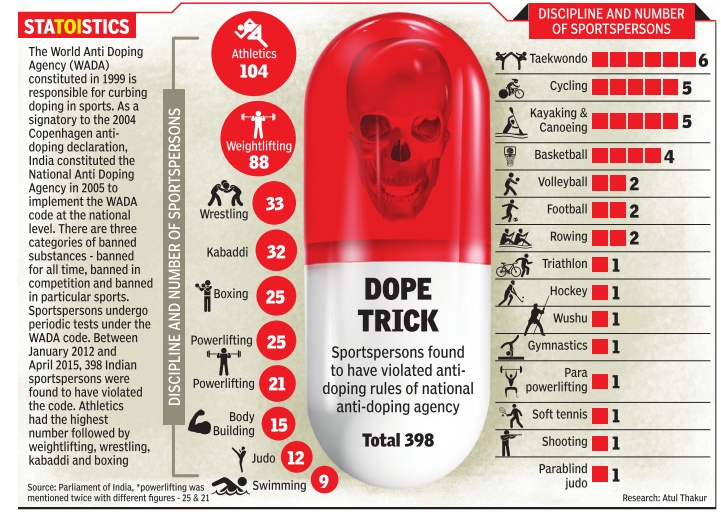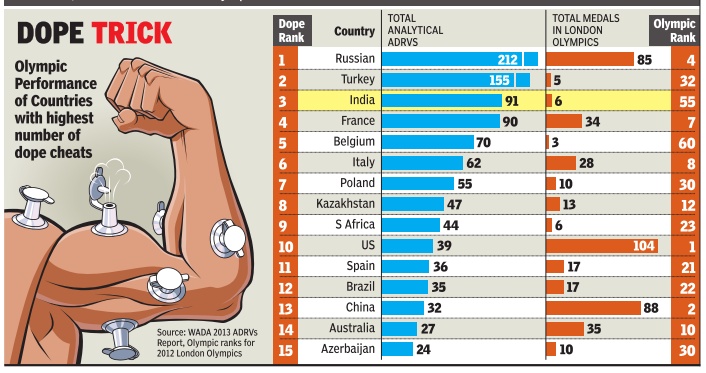Doping in sports: India
(→India and the world: 2012, London Olympics) |
|||
| Line 83: | Line 83: | ||
Despite its best ever haul of six medals in the 2012 London Olympics, India finished 55th in the overall tally. However, when it comes to athletes caught using performance enhancement drugs, the sporting minnow is well ahead of many countries that do much better at the Olympics.A recent report of the World Anti-Doping Agency shows that the total analytical anti-doping rule violation (ADRV) results for Indian athletes in 2013 were the third highest in the world. Russia, which topped the dope cheat list, was ranked 4th in the Olympics | Despite its best ever haul of six medals in the 2012 London Olympics, India finished 55th in the overall tally. However, when it comes to athletes caught using performance enhancement drugs, the sporting minnow is well ahead of many countries that do much better at the Olympics.A recent report of the World Anti-Doping Agency shows that the total analytical anti-doping rule violation (ADRV) results for Indian athletes in 2013 were the third highest in the world. Russia, which topped the dope cheat list, was ranked 4th in the Olympics | ||
| + | |||
| + | =Doping= | ||
| + | ==2016: India no.3 in world== | ||
| + | [http://epaperbeta.timesofindia.com/Article.aspx?eid=31808&articlexml=WADA-report-India-marked-third-in-worldwide-dope-29042016026039 ''The Times of India''], Apr 29 2016 | ||
| + | |||
| + | ''' WADA report: India marked third in worldwide dope violation ''' | ||
| + | |||
| + | Lightweights in the competitive arena but India continued to rule the roost as far as doping was concerned, placed once again in the top three in a WADA report based on the information supplied by various national bodies. | ||
| + | |||
| + | India had the third highest Anti-Doping Rule Violations (ADRVs) in 2014, with 96 cases, behind Russia (148) and Italy (123). Belgium (91), France (91), Turkey (73), Australia (49), China (49), Brazil (46) and South Korea (43) followed India in the top 10, according to the World Anti-Doping Agency (WADA) report released. | ||
| + | |||
| + | ADRV is a doping case in which a decision is rendered against an athlete following a full disciplinary process. The sanction is either a reprimand or a period of ineligibility. Out of the 96 ADRVs recorded by India, four are non analytical (2 each in athletics and wrestling) cases like failure to submit to appear for a test, possession, use or trafficking of a prohibited substance following an investigation. | ||
| + | |||
| + | Out of these 96 dope violations, 79 (56 men and 23 women) failed in-competition tests while 13 (9 men and 4 women) were caught out-of-competition. India, whose medal count in the Olympics has been a mere 24 since 1920, has one of the highest number dope offenders in the last few years. Among the sports which contributed most dope cheats in the country, athletics continued to maintain the top spot with 29 cases, followed by powerlifitng (23) and weightlifting (22) as the trend of the last few years continued. | ||
| + | |||
| + | ''' NATION'S SHAME ''' | ||
| + | |||
| + | India has third highest Anti-Doping Rule Violations in 2014 with 96 cases, behind Russia (148) and Italy (123) Out of 96 violations, 79 (56 men, 23 women) failed in-competition tests while 13 (9 men, 4 women) were caught out-of-competition. | ||
| + | |||
| + | Athletics leads chart of violators with 29 cases, followed by powerlifitng (23) and weightlifting (22) A total of 217,762 samples were tested and analysed in 2014 worldwide by WADA-accredited laboratories. 2287 samples were reported as adverse findings | ||
Revision as of 15:24, 10 November 2016


This is a collection of articles archived for the excellence of their content. |
Contents |
Doping in sports: In brief
The Hindu, July 27, 2016
Depalakshmi K.
What are performance-enhancing drugs?
Performance-enhancing drugs, or PED, are substances used to improve performance in any form of activity. They usually work by causing the body to build more muscles or by limiting muscle fatigue. They are mostly Anabolic Steroids, synthetic versions of the male hormone Testosterone. There are also non-steroidal PEDs. A common example is Ibuprofen, a painkiller that can be bought without a prescription at medical stores. It limits the inflammation associated with physical exercise.
Who decides if a drug is PED or not?
The World Anti-Doping Agency (WADA) monitors doping in all kinds of competitive sports. Created in 1991, WADA is an independent international agency funded by sports organisations and associated countries. It monitors doping in sport based on the World Anti-Doping Code.
At the national-level, there is the National Anti-Doping Agency (NADA), an independent body under Union Ministry of Sports.
What is WADA Code?
The WADA Code or simply the Code is a document aiming to harmonise anti-doping regulations in all sports and across countries. It has been adopted by over 600 sports organisations. The Code works on five aspects:
Prohibited List: The WADA periodically updates its list of Prohibited Substances and Methods. This includes steroids, anabolic agents, stimulants, and gene doping. Some components such as narcotics are permanently banned. Some, like alcohol, are banned only in-competition. Click here to read/download the full list.
Testing and investigations: The Code has prescribed International Standard for Testing and Investigations. It has laid out elaborate procedures to notify athletes, collect samples, conduct tests, and investigate a possible failure to comply these rules. The Code has set 10 anti-doping rule violations (ADRV). Violation of one or more of these rules entertains investigation.
1. Presence of a prohibited substance in an athlete’s sample
2. Use or attempted use of a prohibited substance or method
3. Refusing to submit to sample collection after being notified
4. Failure to file athlete whereabouts information & missed tests
5. Tampering with any part of the doping control process
6. Possession of a prohibited substance or method
7. Trafficking a prohibited substance or method
8. Administering or attempting to administer a prohibited substance or method to an athlete
9. Complicity in an ADRV
10. Prohibited association with sanctioned Athlete Support Personnel
Laboratories: The WADA doesn't directly conduct tests. It gives accreditation to laboratories which adheres to the mandatory International Standard for Laboratories. The Code also elaborately lays down rules on how to collect samples and conduct tests, besides keeping the investigation confidential. The laboratory cannot test commercial products and certify them, without WADA's approval.
Therapeutic Use Exemptions (TUEs): The Code also has provision to provide or seek exemption for certain drugs, if they are used for treating acute or chronic medical condition and if no other alternative option is available for treatment. The use of such drugs should not produce any additional enhancement of performance.
Protection of Privacy and Personal Information: This part of Code deals with the confidentiality clause. The personal information processed in connection with anti-doping activities is protected in adherence to international privacy laws.
When will an athlete be tested?
Any sportsperson competing in national or international events can be asked to give his/her blood and/or urine samples at any point of time by anti-doping agency or sports events committee during the event. Testing can be conducted in-competition and out-of-competition. Usually athletes who bag the finishing positions are tested. In addition, agency can randomly test any accredited athlete, even when not participating in an event.
What is the punishment, if found guilty?
Sanctions for violating anti-doping regulations may range from a reprimand to a life-time ban, according to WADA. The period of ban may vary depending on the type of anti-doping violation, the circumstances of an individual case, the substance, and the possible repetition of an anti-doping rule violation. The decision to strip the medal, however, lies with the sports organisation.
Can the athlete appeal?
The athlete is entitled for a fair hearing and appeal on any decision regarding a positive test or sanction imposed for an anti-doping rule violation. The athlete can also request a re-test — B sample analysis.
What about nutrients or dietary supplements?
There is no blanket ban on using dietary supplements or nutrients. But there has been several instances of dietary supplements containing prohibited substances but are not declared by the manufacturer. WADA does not accept this as an adequate defence and hence the onus is on the athletes to choose their supplements.
India and the world: 2012, London Olympics
The Times of India, Jun 27 2015
Despite its best ever haul of six medals in the 2012 London Olympics, India finished 55th in the overall tally. However, when it comes to athletes caught using performance enhancement drugs, the sporting minnow is well ahead of many countries that do much better at the Olympics.A recent report of the World Anti-Doping Agency shows that the total analytical anti-doping rule violation (ADRV) results for Indian athletes in 2013 were the third highest in the world. Russia, which topped the dope cheat list, was ranked 4th in the Olympics
Doping
2016: India no.3 in world
The Times of India, Apr 29 2016
WADA report: India marked third in worldwide dope violation
Lightweights in the competitive arena but India continued to rule the roost as far as doping was concerned, placed once again in the top three in a WADA report based on the information supplied by various national bodies.
India had the third highest Anti-Doping Rule Violations (ADRVs) in 2014, with 96 cases, behind Russia (148) and Italy (123). Belgium (91), France (91), Turkey (73), Australia (49), China (49), Brazil (46) and South Korea (43) followed India in the top 10, according to the World Anti-Doping Agency (WADA) report released.
ADRV is a doping case in which a decision is rendered against an athlete following a full disciplinary process. The sanction is either a reprimand or a period of ineligibility. Out of the 96 ADRVs recorded by India, four are non analytical (2 each in athletics and wrestling) cases like failure to submit to appear for a test, possession, use or trafficking of a prohibited substance following an investigation.
Out of these 96 dope violations, 79 (56 men and 23 women) failed in-competition tests while 13 (9 men and 4 women) were caught out-of-competition. India, whose medal count in the Olympics has been a mere 24 since 1920, has one of the highest number dope offenders in the last few years. Among the sports which contributed most dope cheats in the country, athletics continued to maintain the top spot with 29 cases, followed by powerlifitng (23) and weightlifting (22) as the trend of the last few years continued.
NATION'S SHAME
India has third highest Anti-Doping Rule Violations in 2014 with 96 cases, behind Russia (148) and Italy (123) Out of 96 violations, 79 (56 men, 23 women) failed in-competition tests while 13 (9 men, 4 women) were caught out-of-competition.
Athletics leads chart of violators with 29 cases, followed by powerlifitng (23) and weightlifting (22) A total of 217,762 samples were tested and analysed in 2014 worldwide by WADA-accredited laboratories. 2287 samples were reported as adverse findings